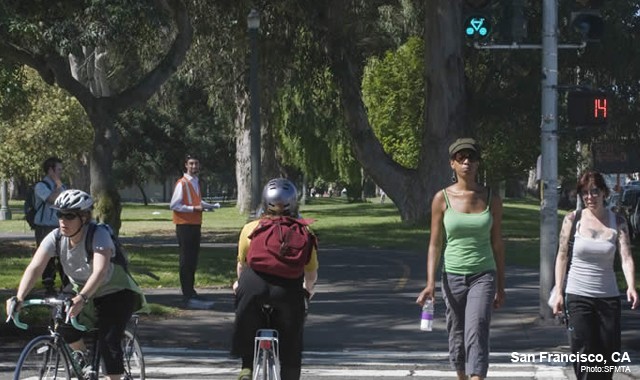
The intersection of Fell Street and Masonic Avenue had a history of collisions between automobiles and users of the Panhandle bicycle and pedestrian path, which runs parallel to Fell Street. During the five–year period from March 2003 through February 2008, there were 15 reported collisions involving a vehicle making a left turn from westbound Fell Street to southbound Masonic Avenue and a bicycle crossing Masonic Avenue; there were three reported collisions involving a vehicle turning left from westbound Fell Street and a pedestrian crossing Masonic Avenue.
The new signal, the first of its kind in the city and installed by the San Francisco Municipal Transportation Agency (SFMTA) in September 2008, provides an exclusive time interval for bicyclists and pedestrians to cross Masonic Avenue together, while automobiles intending to turn left onto Masonic from Fell Street are stopped at the traffic signal. The bicycle component of the new signal uses a bicycle symbol in the familiar green, yellow and red phases to indicate when a bicyclist can cross Masonic Avenue. The pedestrian signal continues to use the white walking figure and the orange hand to direct pedestrian traffic.
Several issues arose as a result of this project:
First, the addition of a bicycle phase was equivalent to separating the through and left phases for vehicles. A left-turn phase for vehicles required the creation of a left-turn lane with sufficient capacity. In this case, that lane required the removal of numerous on-street parking spaces.
Additionally, the phase sequence was an issue. Initially, vehicle left-turns were permitted before the through bike movement. This phasing was chosen because the actuation required for this permitted a longer green bicycle phase. Cyclists felt that this phasing was unfair. Furthermore, many vehicles arriving at the end of the left-turn phase and anxious to avoid waiting an entire cycle would try to pass at the end of the yellow and the beginning of the red, which created an additional conflict with cyclists. Switching the phase sequencing to permit bicycle movements before vehicle left-turns solved these problems. Despite the shorter bicycle green signal necessary because of the less-efficient lagging left-turn actuation, cyclists felt that they were prioritized and vehicles violated the left red arrow less frequently.
Lastly, the location of the signals provided a challenge. Having the through movements (e.g. green ball), turn movements (e.g. red arrow) and bike signal on one pole created an abundance of potential visual conflicts. Louvers have been used to retrofit the existing signal heads, but future upgrades should include separating the various signal faces onto separate poles, including a mast-arm for through movements.
Enforcement and education continue to be needed as vehicles occasionally violate the red arrow and turn into the crosswalk, endangering bicyclists and pedestrians during the protected bicycle/pedestrian phase. After the modifications mentioned above, all user groups seem to be happy with the new signal.
Signal Drawing